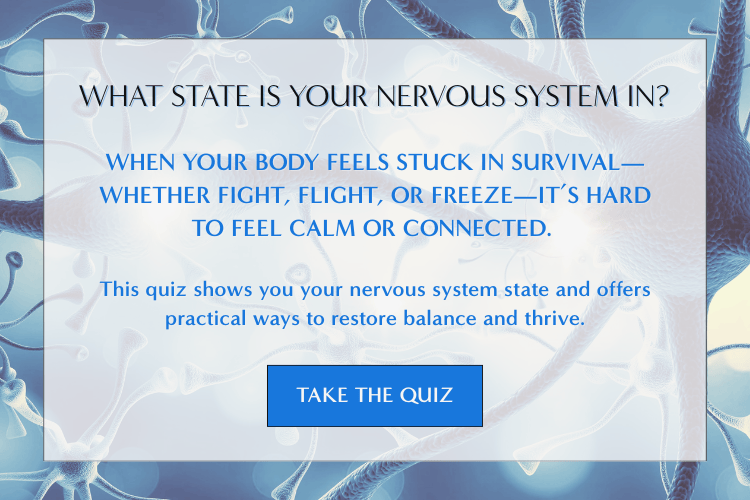Sound Therapy: A Gentle Way to Reset Your Nervous System
In our previous blog post titled Calm Your Nervous System with the Safe Sound Protocol we finished off with this introduction to the effects of sound therapy on how we feel on a day to day basis.
The Safe and Sound Protocol (SSP) and Rest and Restore Protocol (RRP) are evidence‑based listening programs designed to help shift your nervous system toward the top of the ladder — the calm, connected state where healing and resilience happen. (Didn’t catch the blog post that describes our nervous system and the ladder I just referred to? Check it out here)
These powerful sound therapies work by delivering specially filtered music that gently stimulates the part of your nervous system that helps you feel safe & connected. This isn’t hypnosis or meditation — it’s a non‑invasive, research‑supported approach that works with your body’s natural wiring.
And yes — it really is gentle. You listen for short periods, at your own pace, in the comfort of your home, with guidance from a trained provider.
Condimentum id venenatis a condimentum. Leo urna molestie at elementum eu facilisis sed odio. Sit amet purus gravida quis blandit turpis cursus.
A few insights you’ll gain in this article:
The benefits of sound therapy
The difference between the Safe and Sound Protocol (SSP) and the Rest and Restore Protocol (RRP)
Benefits of SSP & RRP Sound Therapy
Calms the fight, flight, freeze response
Deepens relaxation & sense of safety
Reduces stress, anxiety and irritability
Improves sleep quality
Enhances emotional balance and resilience
Supports social engagement (our ability to connect with others)
Encourages deeper rest & recovery
Improves focus and concentration
Helps regulate stress over time
Helps us better recognize cues of safety and danger more accurately
What is the difference between the SSP & RRP?
Ultimately, the SSP is to help us feel safe. That’s a somewhat clinical way of looking at it, so what does that mean for you? You ever find yourself being on the lookout for what could go wrong? Waiting for “the other shoe to fall”? If so, this is a signal that your system is looking for signs that you aren’t ok, and once it’s picked up a signal, your body will go into either protection, or defensive mode to do whatever it takes for you to be ok.
Conversely, the RRP helps us to relax at a deeper level and lean into trusting ourselves. (note that I use the word relax - which is very different from checking out, numbing out, or escaping) Imagine what’s possible when you trust yourself and can think more creatively and less cautiously; you become more open - open within yourself and open towards those in your life.
Who is Sound Therapy For?
Sound therapy can benefit people who:
Feel stressed, anxious, or “on edge” most of the time
Have trouble relaxing or sleeping
Are recovering from emotional or physical stress
Live with the effects of PTSD or C-PTSD
Want to feel more present and connected in daily life
FAQ
Q1: Why would I use Sound Therapy?
A1: This is a great question that sometimes comes up. And my simple answer is “because it works”. I have many clients who see me for counselling to create the lives they dream of; and we also have many clients who only do sound therapy with us; but both are looking for essentially the same outcomes. To feel calmer, more at ease in their lives, and to enjoy their relationships more. The key difference in the different starting points is the depth of struggles that make sound therapy a helpful choice.
Those who pair sound therapy with traditional counselling will generally see more openness in their counselling journey, which helps them reach their counselling goals faster. Those who do it as a stand alone therapy find that it helps them realign with what’s most important to them so that their life is richer and more balanced.
Q2: How do I get the most out of Sound Therapy?
A2: This is my favourite kind of question because this is where the real magic can happen! As with anything, the more “all in” you are, the more you will get out of it. Approach your sound therapy journey with curiosity and openness, with a desire for more, and with hope to accompany it. In practical terms, this might look like setting aside a specific regular time to listen to the music, and developing a rhythm that makes space for some gentle internal questions and reflections. For those who like to journal, it’s a fantastic practice that will certainly help you gain ground during the process.
What Makes Sound Therapy So Effective?
One of the reasons SSP and RRP are so impactful is that they work directly with your body — not against it. You’re not forcing change through willpower or logic alone. Instead, these programs gently shift your internal state in a way that’s hard to access through talking or thinking.
That said, like any meaningful process, the results are shaped by how you engage with it. Below are a few key factors that influence how effective sound therapy will be for you.
Factors That Affect Sound Therapy Effectiveness
Your experience can be shaped by:
Environment: Listening in a calm, quiet space
Equipment: Using over the ear headphones
Pacing: Going at a speed your body can comfortably handle
Support: Having guidance from a trained provider
Integration Time: Allowing your nervous system time to adapt and benefit
You!: You are the single biggest therapeutic piece in your journey, whether it’s sound therapy, traditional counselling, or any other part of your life - and that’s a beautiful thing!
FAQ
Q1: What is the Safe and Sound Protocol?
A1: The SSP is a listening‑based therapy developed by Dr. Stephen Porges that uses filtered music to help your nervous system shift out of survival mode and into a calmer state. It can be delivered in a few musical genres, so there’s something for everyone to enjoy.
Q2: Can I do sound therapy at home?
A2: Yes, you can listen to all of your sound therapy program at home. Most people complete the program at home with support from a trained provider. This makes it easier to fit into your life and do in a setting where you already feel comfortable.
Q3: How long does it take to get started?
A3: We can usually have you up and running within 3-5 business days.
Key Takeaways
Sound therapy is gentle, evidence-based, and designed for real life. You don’t have to meditate, get all emotional or talk through your past to benefit. You just listen, at your own pace, in a setting that feels safe
There’s no “right way” to begin — just your way. Whether you’re using it alongside counselling or as a standalone reset, this is about helping your nervous system feel safer, calmer, and more connected
You don’t have to stay in survival mode. When you feel stuck, short-fused, or like you’ve lost part of yourself, it’s not a personal failure — it’s your nervous system asking for support
Real change starts from within. And your body already knows the way forward. Sometimes it just needs the right signal — and the right support — to begin.
Time to feel better?
You don’t have to stay stuck in never-never land, and you don’t have to keep pushing through. If you’re feeling stuck, wired, or worn out, sound therapy can help your system reset. And we would love to guide you through it.
Let’s connect and get you starting to feel better together.
Was your nervous system been stuck in an unhelpful pattern? I’d love to hear your experiences below.





